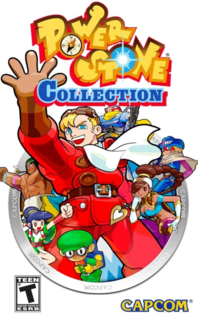This Collection is for anyone that has not seen the "Power Stone" games on either the Dreamcast or the arcade.
Both games share the same graphical engine as it did on the Dreamcast. Thankfully, we get that same graphical engine on the PSP version. There is not much change on it, except for the framerate. It has slowed down a little in the free-for-all contests in "Power Stone 2" and the matches in "Power Stone", but it does not hamper the game too much.
Like the graphics, the audio has not changed much. The same yells and the same music are still there, but that's not necessarily a bad thing. The game does have its moments in terms of music and it makes for a nicely sounding game, despite that the two games are seven to eight years old.
Like everything else, the games themselves are easy to pick up and play. With its responsive and easy controls, it is no wonder that the games are over-the-top fighting games. The controls do feel like it's a plain basic 3D fighter, but that is not necessarily a bad thing. Each button has its own function for attacking, picking up items and tossing foes into places they do not want to be in. It all makes for a fun button-masher, just like it is back in the day.
Both games are included on one UMD disc. A normal match in "Power Stone" flows like this: The match takes place in a large arena with items and other things to use at will. Your character will fight your enemy using traditional means, use items, toss tables and chairs and the like. There are Power Stones littered in the arena. The goal is to grab three of such stones, and your character can transform into a cool-looking monster-style creature. You can then inflict special attacks such as firing projectiles, flaming uppercuts and the like. You can also perform super attacks that will turn the tide of the fight. The gameplay is fast and frantic, just like it used to be. We like it that way.
"Power Stone" is limited to one-on-one fights with 8 selectable characters. "Power Stone 2", however, supports fights of up to four people with even more characters to choose from (12 from the get-go). The single-player campaigns do not take too long to complete (except for "Power Stone" which can take roughly 20 to 30 minutes) and there is not too much to see after that. The single-player versus mode seems a little limited with respect to options. The load times, on the other hand, are a tinge too long. Stages in "Power Stone" took at least 30 seconds to load. The load times in "Power Stone 2" are a little more forgiving. Stages take at least 10 to 15 seconds to load.
With respect to multi-player, there are not too many options revolving that. Like "Super Smash Bros.", "Power Stone" in its core (especially "Power Stone 2") is all about the multi-player. It is what makes the two games fun. You can play against other people who are in the room who have a copy of the game and that's pretty much it. You can try to share the game with people who do not have the game, but all they will get is a single-player demo of the "Power Stone 2" game.
There is a staggering number of extra items and unlockable content exclusively on both games and in the "Collection" portion. You can go to a Item Shop and make new items out of ones you have in Adventure mode in "Power Stone 2". You can unlock extra characters, items and stages for use in both games. In the "Collection" section, regular unlocks include artwork, music tracks, sound effects and movies that are usually in other game compilations. You also have little mini-games to play around in. Oddly enough, they are the mini-games that were once on the Dreamcast's Visual Memory Unit. For those who do not know what a Visual Memory Unit is, it is basically a Memory Card with a crude L.E.D. screen and Game Boy-esque controls. But, these games are there if you are actually bored of the main two games.
"Power Stone Collection" manages to live up to its expectations. With its unique fighting system and unforgettable gameplay, it is no wonder why people cannot find a game like this in an arcade setting. For those who have not witnessed it in the arcade or the Dreamcast, this game is for you. For those who enjoy the Dreamcast originals and own them both, you are likely not finding anything new here.

